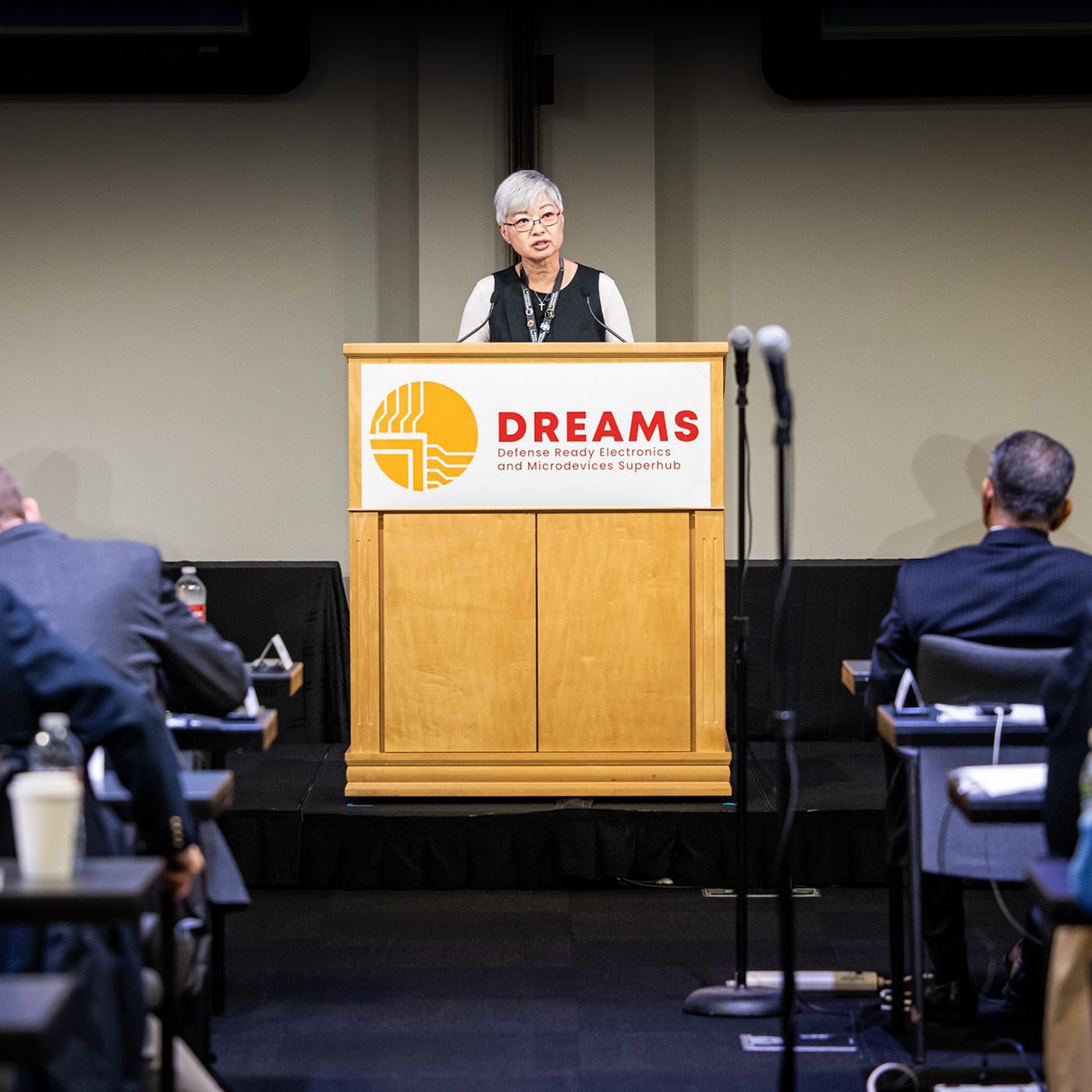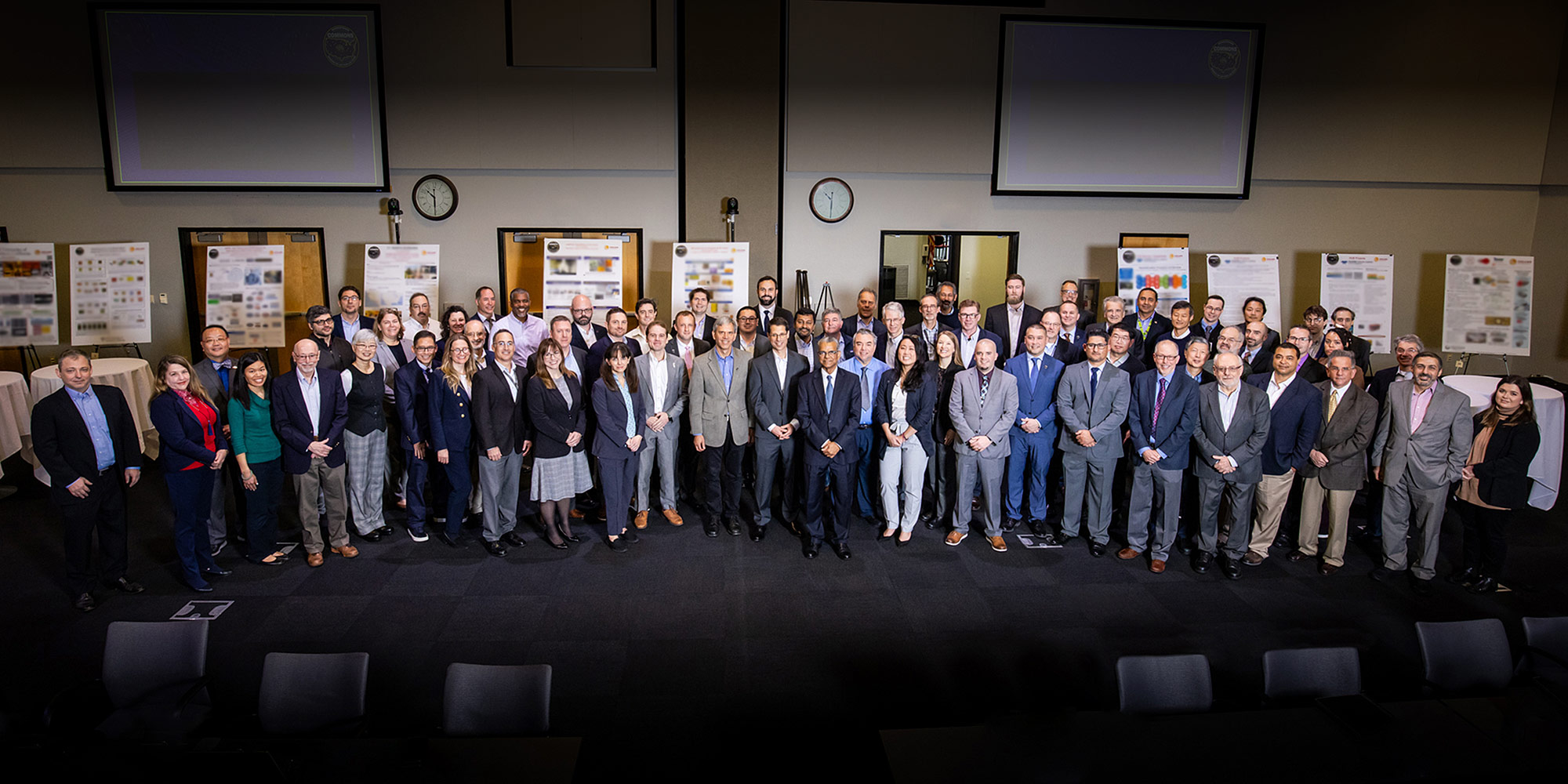By Matt McKinney
REDONDO BEACH (Feb. 19, 2024) – Marking their first official site visit, a select group of government, industry, and academic leaders recently gathered at Northrop Grumman’s Space Park campus to discuss their role in a landmark effort to expand research, development, and production of essential advanced microelectronics technologies in the United States.
“We are here because we are in the business of diversifying the microelectronics manufacturing industry,” said Dr. Dev Shenoy, who leads the U.S. Defense Department’s research and engineering efforts in microelectronics.
The full-day conference brought together leaders of the California Defense Ready Electronics and Microdevices Superhub (California DREAMS), one of eight such regional innovation hubs across the U.S. In total, the centers have already been awarded nearly $240 million in federal funding from the U.S. CHIPS and Science Act.

‘A Generational Opportunity’
During opening remarks, Shenoy described the “generational challenge” facing the nation in expanding advanced microelectronics production. Vital components that power national defense systems are largely manufactured in Asia, exposing the microchip supply chain to myriad risks, he said.
Despite its status as a design leader, the U.S. produces just 12% of chips globally, none of which are sophisticated enough to power advanced national defense technologies, he said.
“The answer to this challenge presents a generational opportunity,” he said, emphasizing the need for strong partnerships and a skilled workforce to effectively deliver on advanced capabilities.
Shenoy called on attendees to collaborate, cultivate, and deliver on bold ideas, identify key areas of expertise not already included in the hub, and build the groundwork to create sustainable independence in the production of advanced microelectronics to support our nation’s military and economic security. Academic and industry partners echoed those priorities throughout the Jan. 22 event.
“From enhancing national security to revolutionizing health care, from enabling space exploration to powering sustainable energy solutions, the impact of microelectronics knows no bounds,” said Gefferie Yee-Madera, vice president of Engineering for Northrop Grumman’s Strategic Space Systems Division (SSSD).
Photo caption: Northrop Grumman's Gefferie Yee-Madera speaking to conference attendees.
Developing Skilled Workers
In a presentation focused on workforce development, Dr. Andrea Belz, California DREAMS director of translational strategy and vice dean at the USC Viterbi School of Engineering, described the microchip-production skills gap and plans to address it.
Although the semiconductor industry is projected to add nearly 115,000 jobs by the end of the decade, 58% of them risk going unfilled due to workforce skill gaps, according to a recent report by the Semiconductor Industry Association. Many such jobs may not require traditional university degrees, according to presenters at the Jan. 22 event.
Bolstering the talent pool presents numerous challenges, including competition from the computer science sector and the large number of graduate students – including more than 70% of Ph.D. students – ineligible to receive security clearances due to their status as non-U.S. citizens, Belz said.
Belz said California DREAMS and its partners aim to double the number of clearable personnel entering fields related to electronics by bolstering regional training, promoting job postings, and more.
“We intend to develop solutions that can be used across the country and can be deployed in all the other hubs,” Belz said.
Results Through Collaboration
Led by USC, California DREAMS comprises 16 founding members and 43 affiliates from academia and industry. In addition to the first-year funding of $26.9 million, the total hub value –including prior equipment investments among funded partners – represents an estimated $500 million.
“Many of the seminal capabilities that have developed in the nation over the last several decades have come out of these groups,” said Dr. Steve Crago, director of California DREAMS and associate director of USC Viterbi’s Information Sciences Institute.
Together, the partners are dedicated to developing real-world capabilities from the advanced materials and devices crafted in academic laboratories, as well as the development of 5G/6G communication technologies.
During a panel discussion among California DREAMS partners, participants said the hub is already yielding results by streamlining processes and creating more frictionless opportunities for collaboration.
“I’ve seen relationship connections that would have taken me a decade – if ever – to create,” said Ashley Danial, chief technologist for Northrop Grumman’s SSSD. “And that’s going to be the foundation that we build upon for the rest of the hub outputs.”
A recent example: During a brief elevator ride, counterparts from USC and Northrop Grumman discovered shared capabilities and interest to pursue a project that would enable them to fit tiny electronic parts together on a base to make more complex technologies, Danial said.
That interaction – made possible through the hub’s non-disclosure agreements, funding, and vision – enabled the project to be put into motion almost immediately, she said.
Regional Strengths
In a presentation on regional strengths, HRL Laboratories Vice President Dr. Franklin Monzon described how far the industry has come since semiconductor industry jobs began moving to East Asia.
After overseeing three rounds of layoffs at his previous company more than a decade ago, Monzon left the industry for several years before returning as domestic production rebounded.
“It’s really great to see that pendulum swinging back,” he said.
Today, Malibu-based HRL Laboratories – a subsidiary co-owned by Boeing and GM – specializes in government research and development contracts, which comprise more than 75% of the company’s research. Dedicated to delivering novel innovations to its commercial partners, the company has won more than 1,700 patents in the last two decades.
Dr. Bobby Brar, president of Teledyne Scientific Company, said what excites him most is the shared expertise among California DREAMS partners. That know-how was “built on the shoulders of giants,” he said, citing the breakthroughs by Northrop Grumman and Teledyne heritage companies, among others.
“We have a vision of what we can do based on where the state of the art is and where it can go, and we have the capability to go and execute on that vision,” he said.
Based in Thousand Oaks, Teledyne has conducted advanced semiconductor development for more than four decades. The Microelectronics Commons is a “natural extension” of its existing work and enables the company to accelerate the pipeline from R&D to prototyping and production, Brar said.
Northrop Grumman’s Role
In December 2023, Northrop Grumman CEO Kathy Warden announced the creation of the Northrop Grumman Microelectronics Center, which combines the semiconductor foundries in the company’s Mission Systems and Space Systems sectors. The center is designed to streamline different parts of the business and technologies, accelerating the company’s ability to meet customer needs.
The January conference included a tour of Space Park’s foundry for roughly 20 attendees, showcasing a key resource in California DREAMS’ efforts to boost American semiconductor research, development, and production. Roughly 250 employees work at the foundry, which specializes in compound semiconductor manufacturing for commercial and government customers alike.
“The tour group was very engaged to learn about our microelectronics and module and electronic assembly and test capabilities,” said Aaron Oki, a Northrop Grumman fellow.
Since the 1950s, the foundry has developed chips that play critical roles in space and missile missions, advanced digital video technologies used in film and television, and revolutionized cellphones.
Today, chips manufactured at Space Park are enabling sea level rise monitoring, unlocking the secrets of the universe, and supporting the defense of the United States and its allies.
“The work that is being done here and at all eight hubs is crucial for all of us, and our work together is vital to the safety and security of the U.S. and its allies,” said Sarah Schellpfeffer, vice president and chief technology officer for Northrop Grumman’s Space Systems Sector.
Click here for more information on California DREAMS.
Photo Caption (top of page): Panelists at the full-day event included representatives from the U.S. Defense Department, USC, UCLA, the California Office of Business & Economic Development, and other California DREAMS partners.
